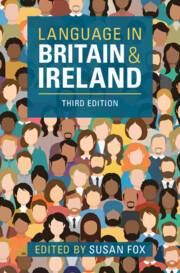Book contents
- Language in Britain and Ireland
- Language in Britain and Ireland
- Copyright page
- Contents
- Figures
- Tables
- Contributors
- Acknowledgements
- Map of Britain and Ireland
- Introduction
- Part I English
- Part II Multilingualism in Britain and Ireland: The Celtic Languages
- Part III Multilingualism in Britain and Ireland: Minority Languages
- 15 Channel Islands French
- 16 South Asian Languages
- 17 Chinese
- 18 Yiddish
- 19 European Immigrant Languages
- 20 Sign Languages in Britain and Ireland
- Part IV Multilingualism: The Development of Urban Contact Varieties
- Part V Applied Sociolinguistic Issues
- Index
- References
15 - Channel Islands French
from Part III - Multilingualism in Britain and Ireland: Minority Languages
Published online by Cambridge University Press: 17 October 2024
- Language in Britain and Ireland
- Language in Britain and Ireland
- Copyright page
- Contents
- Figures
- Tables
- Contributors
- Acknowledgements
- Map of Britain and Ireland
- Introduction
- Part I English
- Part II Multilingualism in Britain and Ireland: The Celtic Languages
- Part III Multilingualism in Britain and Ireland: Minority Languages
- 15 Channel Islands French
- 16 South Asian Languages
- 17 Chinese
- 18 Yiddish
- 19 European Immigrant Languages
- 20 Sign Languages in Britain and Ireland
- Part IV Multilingualism: The Development of Urban Contact Varieties
- Part V Applied Sociolinguistic Issues
- Index
- References
Summary
Although the Channel Islands have been united politically with Great Britain since 1204, each of the four largest islands, Jersey, Guernsey, Sark and Alderney, feature Norman dialects, known locally as Jèrriais, Guernésiais, Sercquiais and Aurignais. For many centuries, these were the main everyday languages of most islanders, and Jèrriais and Guernésiais enjoy a literary tradition dating back to the nineteenth century. Owing to the spread of English throughout the archipelago during the twentieth century in particular, the dialects have all suffered a sharp decline in speaker numbers, with the Norman of Alderney now extinct. The insular varieties are not homogeneous and the linguistic consequences, both lexical and structural, of the extensive language contact between English and the three surviving dialects have served to further differentiate insular Norman from the Norman varieties spoken in mainland Normandy. The realisation that insular Norman is declining rapidly in terms of speaker numbers has prompted the establishment of local language planning measures, currently more established in Jersey than on the other islands.
Keywords
- Type
- Chapter
- Information
- Language in Britain and Ireland , pp. 373 - 385Publisher: Cambridge University PressPrint publication year: 2024

